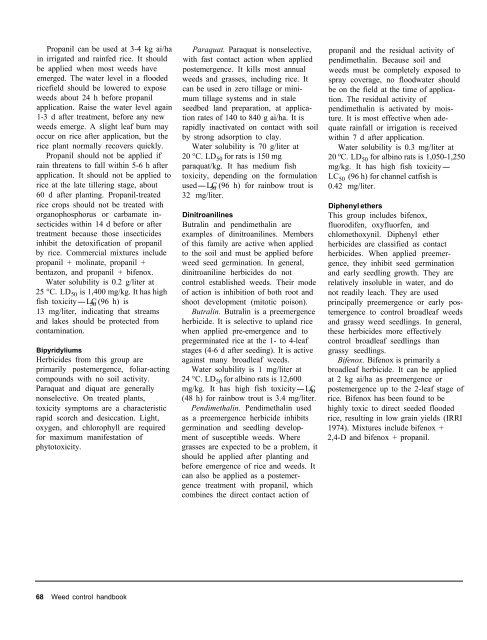A handbbok on Weed Control in Rice.pdf
A handbbok on Weed Control in Rice.pdf
A handbbok on Weed Control in Rice.pdf
Create successful ePaper yourself
Turn your PDF publications into a flip-book with our unique Google optimized e-Paper software.
Propanil can be used at 3-4 kg ai/ha<br />
<strong>in</strong> irrigated and ra<strong>in</strong>fed rice. It should<br />
be applied when most weeds have<br />
emerged. The water level <strong>in</strong> a flooded<br />
ricefield should be lowered to expose<br />
weeds about 24 h before propanil<br />
applicati<strong>on</strong>. Raise the water level aga<strong>in</strong><br />
1-3 d after treatment, before any new<br />
weeds emerge. A slight leaf burn may<br />
occur <strong>on</strong> rice after applicati<strong>on</strong>, but the<br />
rice plant normally recovers quickly.<br />
Propanil should not be applied if<br />
ra<strong>in</strong> threatens to fall with<strong>in</strong> 5-6 h after<br />
applicati<strong>on</strong>. It should not be applied to<br />
rice at the late tiller<strong>in</strong>g stage, about<br />
60 d after plant<strong>in</strong>g. Propanil-treated<br />
rice crops should not be treated with<br />
organophosphorus or carbamate <strong>in</strong>-<br />
secticides with<strong>in</strong> 14 d before or after<br />
treatment because those <strong>in</strong>secticides<br />
<strong>in</strong>hibit the detoxificati<strong>on</strong> of propanil<br />
by rice. Commercial mixtures <strong>in</strong>clude<br />
propanil + mol<strong>in</strong>ate, propanil +<br />
bentaz<strong>on</strong>, and propanil + bifenox.<br />
Water solubility is 0.2 g/liter at<br />
25 °C. LD 50 is 1,400 mg/kg. It has high<br />
fish toxicity-LC<br />
50 (96 h) is<br />
13 mg/liter, <strong>in</strong>dicat<strong>in</strong>g that streams<br />
and lakes should be protected from<br />
c<strong>on</strong>tam<strong>in</strong>ati<strong>on</strong>.<br />
Bipyridyliums<br />
Herbicides from this group are<br />
primarily postemergence, foliar-act<strong>in</strong>g<br />
compounds with no soil activity.<br />
Paraquat and diquat are generally<br />
n<strong>on</strong>selective. On treated plants,<br />
toxicity symptoms are a characteristic<br />
rapid scorch and desiccati<strong>on</strong>. Light,<br />
oxygen, and chlorophyll are required<br />
for maximum manifestati<strong>on</strong> of<br />
phytotoxicity.<br />
68 <strong>Weed</strong> c<strong>on</strong>trol handbook<br />
Paraquat. Paraquat is n<strong>on</strong>selective,<br />
with fast c<strong>on</strong>tact acti<strong>on</strong> when applied<br />
postemergence. It kills most annual<br />
weeds and grasses, <strong>in</strong>clud<strong>in</strong>g rice. It<br />
can be used <strong>in</strong> zero tillage or m<strong>in</strong>i-<br />
mum tillage systems and <strong>in</strong> stale<br />
seedbed land preparati<strong>on</strong>, at applica-<br />
ti<strong>on</strong> rates of 140 to 840 g ai/ha. It is<br />
rapidly <strong>in</strong>activated <strong>on</strong> c<strong>on</strong>tact with soil<br />
by str<strong>on</strong>g adsorpti<strong>on</strong> to clay.<br />
Water solubility is 70 g/liter at<br />
20 °C. LD 50 for rats is 150 mg<br />
paraquat/kg. It has medium fish<br />
toxicity, depend<strong>in</strong>g <strong>on</strong> the formulati<strong>on</strong><br />
used-LC<br />
50 (96 h) for ra<strong>in</strong>bow trout is<br />
32 mg/liter.<br />
D<strong>in</strong>itroanil<strong>in</strong>es<br />
Butral<strong>in</strong> and pendimethal<strong>in</strong> are<br />
examples of d<strong>in</strong>itroanil<strong>in</strong>es. Members<br />
of this family are active when applied<br />
to the soil and must be applied before<br />
weed seed germ<strong>in</strong>ati<strong>on</strong>. In general,<br />
d<strong>in</strong>itroanil<strong>in</strong>e herbicides do not<br />
c<strong>on</strong>trol established weeds. Their mode<br />
of acti<strong>on</strong> is <strong>in</strong>hibiti<strong>on</strong> of both root and<br />
shoot development (mitotic pois<strong>on</strong>).<br />
Butral<strong>in</strong>. Butral<strong>in</strong> is a preemergence<br />
herbicide. It is selective to upland rice<br />
when applied pre-emergence and to<br />
pregerm<strong>in</strong>ated rice at the 1- to 4-leaf<br />
stages (4-6 d after seed<strong>in</strong>g). It is active<br />
aga<strong>in</strong>st many broadleaf weeds.<br />
Water solubility is 1 mg/liter at<br />
24 °C. LD 50 for alb<strong>in</strong>o rats is 12,600<br />
mg/kg. It has high fish toxicity-LC<br />
50<br />
(48 h) for ra<strong>in</strong>bow trout is 3.4 mg/liter.<br />
Pendimethal<strong>in</strong>. Pendimethal<strong>in</strong> used<br />
as a preemergence herbicide <strong>in</strong>hibits<br />
germ<strong>in</strong>ati<strong>on</strong> and seedl<strong>in</strong>g develop-<br />
ment of susceptible weeds. Where<br />
grasses are expected to be a problem, it<br />
should be applied after plant<strong>in</strong>g and<br />
before emergence of rice and weeds. It<br />
can also be applied as a postemer-<br />
gence treatment with propanil, which<br />
comb<strong>in</strong>es the direct c<strong>on</strong>tact acti<strong>on</strong> of<br />
propanil and the residual activity of<br />
pendimethal<strong>in</strong>. Because soil and<br />
weeds must be completely exposed to<br />
spray coverage, no floodwater should<br />
be <strong>on</strong> the field at the time of applica-<br />
ti<strong>on</strong>. The residual activity of<br />
pendimethal<strong>in</strong> is activated by mois-<br />
ture. It is most effective when ade-<br />
quate ra<strong>in</strong>fall or irrigati<strong>on</strong> is received<br />
with<strong>in</strong> 7 d after applicati<strong>on</strong>.<br />
Water solubility is 0.3 mg/liter at<br />
20 ºC. LD 50 for alb<strong>in</strong>o rats is 1,050-1,250<br />
mg/kg. It has high fish toxicity-<br />
LC 50 (96 h) for channel catfish is<br />
0.42 mg/liter.<br />
Diphenyl ethers<br />
This group <strong>in</strong>cludes bifenox,<br />
fluorodifen, oxyfluorfen, and<br />
chlomethoxynil. Diphenyl ether<br />
herbicides are classified as c<strong>on</strong>tact<br />
herbicides. When applied preemer-<br />
gence, they <strong>in</strong>hibit seed germ<strong>in</strong>ati<strong>on</strong><br />
and early seedl<strong>in</strong>g growth. They are<br />
relatively <strong>in</strong>soluble <strong>in</strong> water, and do<br />
not readily leach. They are used<br />
pr<strong>in</strong>cipally preemergence or early pos-<br />
temergence to c<strong>on</strong>trol broadleaf weeds<br />
and grassy weed seedl<strong>in</strong>gs. In general,<br />
these herbicides more effectively<br />
c<strong>on</strong>trol broadleaf seedl<strong>in</strong>gs than<br />
grassy seedl<strong>in</strong>gs.<br />
Bifenox. Bifenox is primarily a<br />
broadleaf herbicide. It can be applied<br />
at 2 kg ai/ha as preemergence or<br />
postemergence up to the 2-leaf stage of<br />
rice. Bifenox has been found to be<br />
highly toxic to direct seeded flooded<br />
rice, result<strong>in</strong>g <strong>in</strong> low gra<strong>in</strong> yields (IRRI<br />
1974). Mixtures <strong>in</strong>clude bifenox +<br />
2,4-D and bifenox + propanil.











